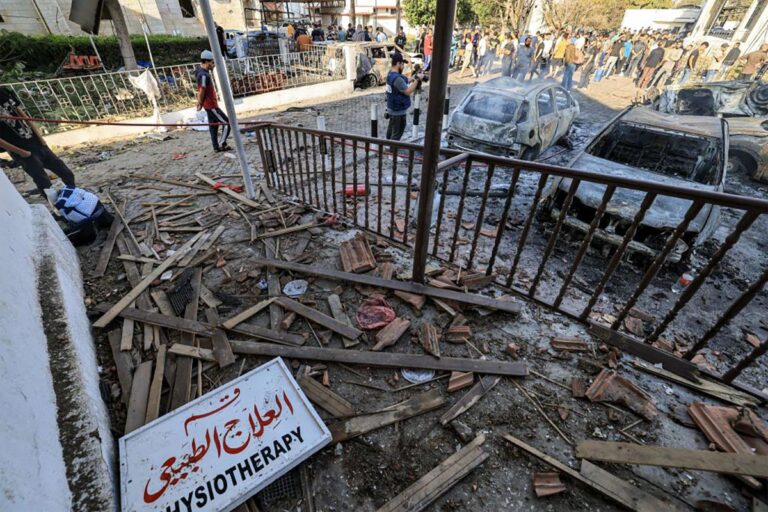
An explosion at Al-Ahli Arab Hospital in Gaza City killed over 100 people and left hundreds injured.
Despite some news outlets publishing the claims by Hamas blaming Israel, the IDF produced evidence that it was a Palestinian Islamic Jihad rocket misfiring. Hamas did not produce evidence backing up their claim that Israel was responsible.
The IDF accused the terrorist group of firing 10 rockets at Israel at the time of the explosion and one misfired prematurely and hit the hospital as a result. Both European and U.S. intelligence backed up Israel’s version of events.
The Hamas-run Gaza health ministry blamed the blast on an Israeli airstrike and initially claimed that 500 people were killed by the “crime of genocide” against the hospital. However, intelligence believes these numbers were greatly inflated.
In the days following the explosion, as the intelligence community pieced together what happened at the hospital, millions of people had read incorrect claims on the events and protests had taken over cities in the Middle East.
Let’s delve deeper into what happened at Al-Ahli Arab Hospital and how the misinformation was spread.
What really happened at Al Ahli Arab Hospital?
On October 17, an explosion at the hospital’s parking lot killed 100-300 people, according to U.S. intelligence.
Videos of the moments of the blast show an explosion on the hospital grounds, causing the surrounding area to go up in flame and smoke.
Experts claim that a blast analysis indicates that the blast was a ground explosion and not an airstrike. The parking lot has no single crater that a bomb would create and the extensive fire damage and the way that the debris scattered closely resembles a ground explosion.
Islamic Jihad posted a message on Telegram, a messaging app, claiming to have fired multiple rockets toward Israel, just minutes after the hospital explosion took place.
Live footage from Al-Jazeera shows a bright blight in the sky of Gaza City which flashes twice before turning directions and exploding. The explosion was then followed by a bigger blast, which intelligence officials are claiming to be a rocket exploding or disintegrating.
In addition, the IDF released audio that reportedly captured Hamas militants speaking of a rocket launch from a cemetery close to the hospital.
A translation of the recording shows one speaker saying, “They are saying that the shrapnel of the missile is local shrapnel and not like the Israeli shrapnel.”
How did the international community respond?
The U.S. and the E.U. backed up Israel’s claims, with U.S. National Security Council spokesperson Adrienne Watson saying, “Our current assessment, based on analysis of overhead imagery, intercepts and open source information, is that Israel is not responsible for the explosion.”
Aerial photos taken by the U.S., evaluations of the scene, and investigations by independent analysts show that the damage caused by the blast was not consistent with an Israeli airstrike as there was not enough cratering nor damage for the caliber of weapon created by the Israelis.
In his speech from the Oval Office this past weekend, President Joe Biden stated that the hospital explosion “was not done by the Israelis.”
A U.S. intelligence official elaborated on this, telling NBC News, “We assess with high confidence that Israel was not responsible for the explosion at the hospital and that Palestinian militants were responsible. We assess with low confidence that Palestine Islamic Jihad was responsible for launching the rocket that landed on the hospital.”
However, in response to the blast and the U.S. backing up Israel, Palestinian leaders pulled out of a summit between them, Jordan, Egypt and Biden. Subsequently, the king of Jordan canceled the event altogether.
Many Arab countries, including Saudi Arabia, Jordan, Egypt, the United Arab Emirates and Iraq, issued statements accusing the Israeli military of bombing the hospital.
What was the response by the media?
In the hours following the tragedy, many media organizations began publishing reports blaming the Israeli government for the blast.
News organizations like the New York TImes, the Washington Post, Reuters, the Associated Press and CNN initially published Hamas’ claims on the blast and faced criticism for blaming Israel with no evidence.
“Hundreds killed in Israeli airstrike on Gaza City hospital, Health Ministry says,” the Associated Press headline read.
“At least 500 people were killed by an Israeli airstrike at a Gaza hospital, the Palestinian Health Ministry said,” headlined The New York Times’ article.
“Hundreds feared dead or injured in Israeli air strike on hospital in Gaza, Palestinian officials say,” wrote the BBC.
Almost a week later, in an editors’ note, the New York Times acknowledged the faults in their reporting and role their article played in spreading misinformation.
“The early versions of the coverage — and the prominence it received in a headline, news alert and social media channels — relied too heavily on claims by Hamas, and did not make clear that those claims could not immediately be verified,” the newspaper wrote. “The report left readers with an incorrect impression about what was known and how credible the account was.”
“Times editors should have taken more care with the initial presentation,” the statement continued.
The BBC also issued an apology statement for a correspondent claiming that “It’s hard to see what else this could be really given the size of the explosion other than an Israeli air strike,” but did not address its alerts and initial reporting which blamed Israel for the explosion.
“We accept that even in this fast-moving situation it was wrong to speculate in this way,” the statement said.
All of these outlets reported that hundreds, and some reported up to a thousand, had died in the blast when the true death toll, according to U.S. and European assessments, was 100-300.
How did public figures respond?
Politicians also spread misinformation about the blast and cast blame on Israel.
Palestinian-American congresswoman Rashida Tlaib wrote on X: “Israel just bombed the Baptist Hospital killing 500 Palestinians (doctors, children, patients) just like that.”
Fellow congresswoman Ilhan Omar also blamed Israel for the explosion, writing on X:
“Bombing a hospital is among the gravest of war crimes. The IDF reportedly blowing up one of the few places the injured and wounded can seek medical treatment and shelter during a war is horrific.”
Neither Tlaib nor Omar deleted or clarified their posts after evidence was released showing that Israel was not responsible.
Congressman Jared Moskowitz called for Congress to censure Tlaib over her refusal to acknowledge the U.S. findings about the hospital.
“Any member of Congress who continues to trust Hamas’s information over US information is obviously deeply concerning,” Moskowitz said.
Meanwhile, Congressman Ritchie Torres blasted those who did not condemn the hospital explosion when it was found to be a Palestinian rocket.
“Not a word condemning Islamic Jihad for causing the hospital explosion in Gaza and killing hundreds of Palestinian civilians. Not a word from the UN. Not a word from Israel’s usual critics, who rushed to judgment with a blood libel. Not a word from Hamas (no surprises).
“The sudden silence is deafening. If you think the death of Palestinians is cause for outrage only when Israel is the accused, then you are not pro-Palestinian. You are simply anti-Israel. There is a difference,” he wrote on X.
Not a word condemning Islamic Jihad for causing the hospital explosion in Gaza and killing hundreds of Palestinian civilians.
— Ritchie Torres (@RitchieTorres) October 19, 2023
Not a word from the UN.
Not a word from Israel’s usual critics, who rushed to judgement with a blood libel.
Not a word from Hamas (no surprises).…
The algorithm on X has made it easier for misinformation to spread
Misinformation campaigns using fake headlines and eyewitness accounts, unverified information and old videos were rampant online, promoting false narratives about the events.
One viral video claiming to depict the hospital blast was actually dated to be from 2022.
The Israeli government posted its own video of the blast, believed to be from a reputable source, but the post was later revised to remove the video after it was revealed that it was timestamped from after the explosion took place. This was separate from the evidence the IDF provided to intelligence agencies.
An X account claiming to be an Al Jazeera journalist claimed they saw evidence showing that Hamas bombed the hospital. The news outlet wrote that it has no journalist under that name working for them.
The algorithm of X changed after Elon Musk took control of the company. Formerly, only official sources received a verified blue check from the company. Now, any customer willing to pay to become “verified” is rewarded with the blue check and higher placement of posts in the platform’s feed, regardless of whether the information is true or not.
NewsGuard, a company that rates news and social media platforms for trustworthiness, reported that nearly 75% of the 250 most-engaged posts on X that promoted fake news or unverified information about the war in Israel came from blue checkmarked X users.
One “verified” user posted a fake screenshot of a fake Facebook page pretending to be the IDF with a post taking responsibility for the hospital attack. The manufactured post received more than a million views before being taken down; many accounts have continued to repost the screengrab.
Originally Published Oct 27, 2023 11:06AM EDT
